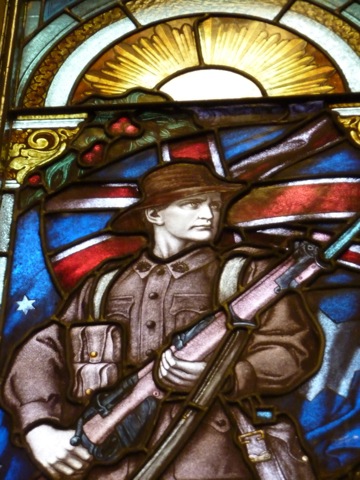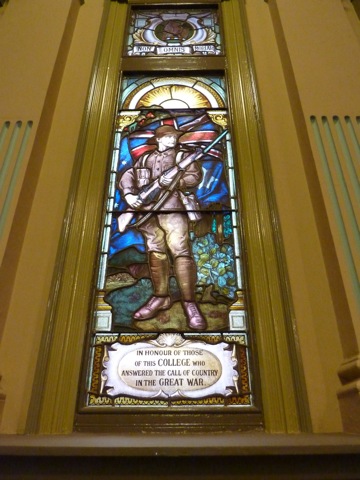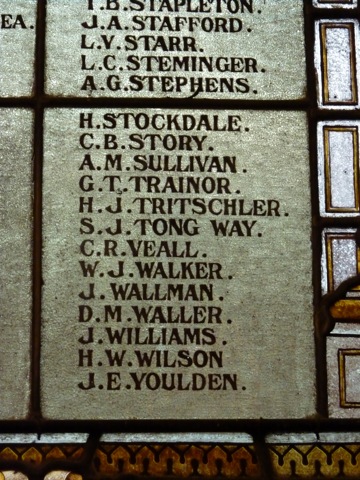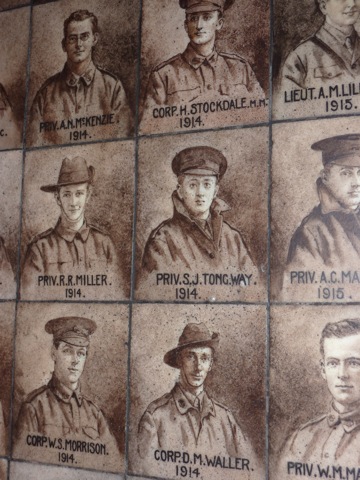
I recently attended a function in the Gryphon Gallery of the 1888 Building at the University of Melbourne, where there’s a local war memorial I missed out on when I last wrote on the topic. It was dedicated in 1920 in what was then the Teachers’ College, and takes the form of three stained glass windows. The central window — seen above and below — depicts an Australian soldier, rifle to the ready, bayonet fixed. He represents all those former students and staff members who served in the Australian Imperial Force (including at least two women).

The inscription at the bottom reads
IN HONOUR OF THOSE
OF THIS COLLEGE WHO
ANSWERED THE CALL OF COUNTRY
IN THE GREAT WAR.
The one at the top is the college Latin motto, from Horace,
NON OMNIS MORIAR
which gives the title of this post.

The windows on either side give the names of nearly all who served (a pamphlet put out by the Ian Potter Museum of Art, clearly the result of a considerable amount of historical spadework, lists some more). Those who died have a section devoted to them at the very top.
I was intrigued by one of the names, S. J. Tong Way. It stands out among all the other, Anglo-Saxon names. I thought perhaps he was descended from one of the Chinese immigrants who came to Victoria during the gold rush era. And it seems that’s the case. A Samuel Tong Way is mentioned, along with his brother Hedley, on an Australian government website as an example of a Chinese Australian who joined up, in his case in the Signal Corps. But despite being an Australian citizen, he wasn’t allowed to do so until after 1916, when China joined the Allies. Tong Way (or Tongway) graduated in March 1917 with a Diploma of Education, and after the war became a primary school teacher (in 1935 he appealed against a non-promotion). He served again in the Second World War as an ‘instructor’, and then took part in returned servicemen activities. After that I lose track of him.

And here’s a picture of Private Tong Way, from another part of the memorial which has become detached from the windows shown above, a pair of tablets with ceramic portraits of the college’s veterans (now in the Graduate Student Association foyer, in the west wing of the 1888 Building). This is apparently a quite unusual form of memorial, and I’m glad the tablets have been rescued from the storeroom in which they languished for several decades. The windows were also covered up for a while but have also been restored to their former glory. They’re well worth a visit though you should check with the Melbourne School of Graduate Research in advance.
![]() This work is licensed under a Creative Commons Attribution-NonCommercial-NoDerivatives 4.0 International License.
Permissions beyond the scope of this license may be available at http://airminded.org/copyright/.
This work is licensed under a Creative Commons Attribution-NonCommercial-NoDerivatives 4.0 International License.
Permissions beyond the scope of this license may be available at http://airminded.org/copyright/.



Fascinating. I’ve never seen a war memorial in Australia with so many portraits before.
Have you read Ken Inglis’ masterwork, Sacred Places?
Samuel John Tong Way’s First World War service record is available to read online at the National Archives of Australia. (Service Number – 19531). He also used “Tong-Way”
– His occupation upon enlistment was given as “High School Teacher” and his address as “The Manse” Young St., Ballarat East, Victoria.
– His father was Reverend John Tong-Way.
– In 1966 he made application for repatriation benefits, apparently on the basis of his WWI service.
– He may have died in 1988.
Hedley David Tong-Way (WWI Service Number – 20455) certainly suited up again for WWII (http://www.ww2roll.gov.au/script/veteran.asp?ServiceID=A&VeteranID=653016) , but I can’t find any indication at NAA or the WWII nominal roll that Samuel John did so.
Within the National Archives, the application for naturalisation by Rev. John Tong Way and the subsequent refusal make sobering reading. Good enough to send his sons to war, but not good enough to be one of us. Chinese were not being accepted for naturalisation.
Brett, now that I’ve read your excellent 2007 post about war memorials I see you are totally familiar with Ken Inglis’ book.
D’oh! I didn’t even think to look up his service record. Thanks for that. I note that according to his attestation paper, Samuel had been previously rejected for service on the basis of his ‘non European origin’, presumably before China joined the war.
And no, haven’t read Inglis yet, but it’s on the bookshelf …
Hedley Tong Way, we new him as Hedley Way was my step grandfather. I was born in Adelaide SA 1954 where Hedley lived until his death in mid 1970’s. Buried at Cennential Park Cemetary Adelaide. Sorry I don’t have his exact date of death. Hedley married my mother’s mother. I know of one other relative outside of my direct family who is related in a similar way to myself. The Tong Way family lived in Ballarat where my relative still lives today 2014. I am trying to find out where Hedley or Samuel served in the wars. I am visiting the western front for Anzac Day in 2014. My own father was a British seaman in WW2 and was demobbed in Sydney and the married my mother. Lucky for me.
Have you looked at their service records in the National Archives of Australia? You can glean a fair bit about their wartime movements. Go to http://recordsearch.naa.gov.au and just type in their names; Hedley’s and Samuel’s have both been digitised. Their respective units’ war diaries might also be of help.
I’m looking for any old pictures etc. as I currently own the ‘Tong Way’ family home which I’m restoring.